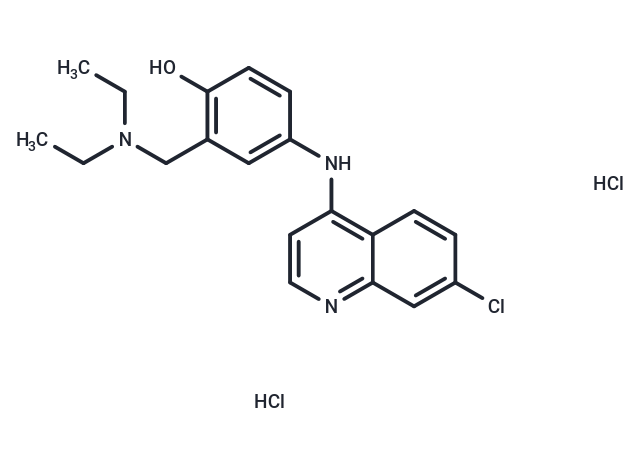Shopping Cart
Remove All Your shopping cart is currently empty
Your shopping cart is currently empty
Amodiaquine dihydrochloride (Amodiaquin dihydrochloride), a member of the 4-aminoquinoline class, is an antimalarial agent that also acts as a potent oral histamine N-methyltransferase inhibitor with a K i value of 18.6 nM. Additionally, it functions as a Nurr1 agonist, targeting the Nurr1-LBD (ligand binding domain) with an EC 50 of approximately 20 μM, demonstrating anti-inflammatory effects [1] [2] [3] [4] [5].

| Pack Size | Price | USA Warehouse | Global Warehouse | Quantity |
|---|---|---|---|---|
| 100 mg | Inquiry | 1-2 weeks | 1-2 weeks |
| Description | Amodiaquine dihydrochloride (Amodiaquin dihydrochloride), a member of the 4-aminoquinoline class, is an antimalarial agent that also acts as a potent oral histamine N-methyltransferase inhibitor with a K i value of 18.6 nM. Additionally, it functions as a Nurr1 agonist, targeting the Nurr1-LBD (ligand binding domain) with an EC 50 of approximately 20 μM, demonstrating anti-inflammatory effects [1] [2] [3] [4] [5]. |
| In vitro | Amodiaquine treatment ranging from 10-20 μM for 4 hours significantly reduces the expression of proinflammatory cytokines (IL-1β, interleukin-6, TNF-α, and iNOS) induced by LPS in a dose-dependent manner. Additionally, at a concentration of 5 μM over 24 hours, Amodiaquine markedly diminishes 6-OHDA-induced cell death in primary dopamine neurons, as evidenced by the preservation of TH+ neuron numbers and dopamine uptake. This neuroprotective effect is corroborated in rat PC12 cells. RT-PCR results from primary microglia treated with 10 μM, 15 μM, and 20 μM Amodiaquine for 4 hours further confirm the suppression of LPS-induced proinflammatory cytokine expression, demonstrating Amodiaquine’s potent anti-inflammatory and neuroprotective activities. |
| In vivo | Amodiaquine administration (40 mg/kg; intraperitoneal injection; daily for 3 days) in male ICR mice aged 8-10 weeks with induced intracerebral hemorrhage (ICH) significantly diminished the activation of perihematomal microglia/macrophages and astrocytes. Furthermore, the treatment effectively suppressed ICH-induced mRNA expression levels of IL-1β, CCL2, and CXCL2, concurrently ameliorating the motor dysfunction observed in these animals. |
| Molecular Weight | 428.78 |
| Formula | C20H24Cl3N3O |
| Cas No. | 69-44-3 |
| Relative Density. | 1.31g/cm3 |
| Storage | Powder: -20°C for 3 years | In solvent: -80°C for 1 year | Shipping with blue ice/Shipping at ambient temperature. |
| Size | Quantity | Unit Price | Amount | Operation |
|---|

Copyright © 2015-2025 TargetMol Chemicals Inc. All Rights Reserved.